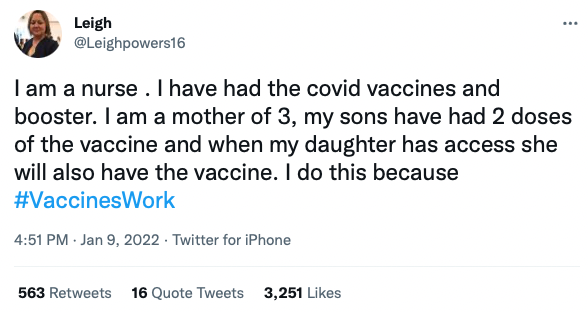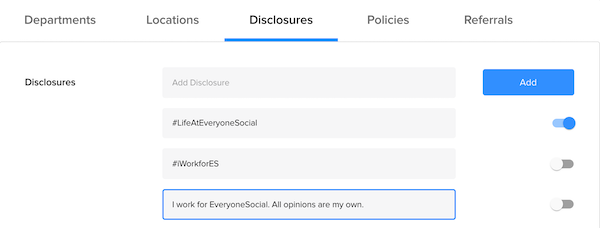Today, organizations from hospitals to pharmaceutical companies operate branded social accounts.
But it’s not just the healthcare industry’s social media managers who share, post, tweet, and comment.
Healthcare workers — of which there are 22 million in the U.S. alone — are also active on social media, including 90% of physicians.
Despite this widespread use of social, healthcare organizations understandably have qualms about inviting employees to use social media at work. There’s concern about employees sharing confidential information or workers becoming involved in heated online discussions that spark a PR nightmare, for example.
The current political climate and the wealth of misinformation on social channels today further complicates the situation.
That said, not encouraging healthcare employees to be social is actually a much bigger risk for companies because they miss out on incredible ROI.
How Activating Employee Networks Helps the Healthcare Industry
There are numerous reasons why healthcare organizations like Cardinal Health and Illumina see value in social media in the workplace and teamed up with EveryoneSocial to tap into the power of employee advocacy.
It fosters trust.
When it comes to making a choice — whether it’s a personal health decision or a purchasing decision — people trust the recommendations of real people more than they do a corporation.
Just check out these stats:
- 84% of people value personal recommendations over all other forms of advertising.
- 90% of 18-24 year-olds say they trust medical information shared by people in their social networks
- 60% of social media users trust doctors’ social posts more than any other group
- 41% of people say that social media would affect their choice of doctor, hospital, or medical facility
So when a healthcare organization promotes vaccinations or a biotech company touts its latest innovation, for example, their efforts go further when employees themselves — doctors, nurses, researchers, etc. — post about these initiatives on social media.
Social bonds are so important in spreading healthcare information that organizations rely heavily on them to encourage people to get vaccinated and post “vaxxies,” or vaccine selfies.
It’s one thing for a pharmaceutical company to recommend you get vaccinated, but it’s entirely more effective when you get that message from your own doctor, a nurse, or a close friend.

Healthcare companies with a solid employee advocacy program in place can take advantage of this and get much greater reach on social media. In fact, employee-shared messages go 561% further than those shared by brand channels.
It improves communication.
Effective communication is important in the workplace, and it’s essential in the healthcare industry where distributing the right information in the best way possible can be a matter of life and death.
However, nearly three quarters of employees miss out on important company news and cite communication breakdowns as the cause for most work failures.
An employee advocacy solution like EveryoneSocial helps prevent these communication failures because it does the following and more:
- Organizes all your content in one place and makes it easy to share with just one click
- Makes conversations among employees accessible and transparent
- Enables knowledge sharing
- Integrates with tools you already use, like Slack and Microsoft Teams
- Fosters a culture of open communication
It enhances your employer brand and attracts talent.
When your employees choose to share company news and content with their personal social networks, it shows that your organization is a great place to work and that your workers believe in the product or service the company offers.
That’s not only what current and potential customers want to see, but also potential employees.
A strong employer brand attracts the best talent, and employer brand-related posts are the very kind that job seekers look for, regardless of the industry.
In fact, 84% of job seekers say a company’s reputation is important, and 90% percent of candidates say they’ll apply for a job at an organization where the employer brand is actively maintained.
It shortens the sales cycles.
These days, social media isn’t only the place where people go for medical information and healthcare recommendations. It’s also where potential customers go to connect with salespeople in the healthcare industry and learn about their offerings.
An employee advocacy solution like EveryoneSocial nurtures these relationships, making it easy for salespeople to share relevant content and connect with the very people who are interested in their products.
It’s called social selling, and it works, driving increased pipeline, better win rates, and up to 48% bigger deals.
How to Get the Most Out of Healthcare Employees’ Networks
Ready to tap into the power of employees’ social networks and generate ROI for your healthcare organization? Here are the steps to take.
Determine program goals.
There’s no shortage of benefits to employee advocacy in the healthcare industry, and you can certainly do it all. But before launching your program, it’s important to understand your goals and the scope of the program.
Do you want to initially focus on improving your employer brand or use advocacy primarily for marketing?
Will you launch your advocacy program company-wide or begin with specific departments or employee influencers?
There’s a lot to consider, so do your research, determine what would benefit the organization most, and be sure to develop a strong content strategy.
Establish a social media policy.
Only 31% of healthcare companies have social media policies, according to the Institute of Health, but every organization needs one. Here’s why:
- It protects the company.
- It makes employees more likely to post.
- It primes your advocacy program for success.
Don’t have a social media policy in place yet?
Check out these tips from the National Institutes of Health and follow these guidelines to create a policy that’ll foster social shares that benefit both employees and your company.
Take precautions.
In an industry as regulated as healthcare, you understandably want some safeguards in place when you launch your employee advocacy program.
Here’s what we recommend:
- Upload your social media policy. Add your social guidelines to EveryoneSocial, so it’s easily accessible to every user.
- Use disclosures.These are phrases or hashtags that are added to all shares that originate from EveryoneSocial. American Family Insurance, for example, uses #iWork4AmFam.
- Include pre-written share copy. You can ensure that all shares from EveryoneSocial feature the exact copy you want to accompany a specific piece of content, or you can toggle a button to allow users to craft (or edit) their own.
- Create private groups. If there’s some content you want accessible only to certain employees — such as those that hold certain licenses or certifications — take advantage of EveryoneSocial’s private groups feature to allow only those specific users to see, engage, or share that content.

Train employees.
Seventy-five percent of workers don’t receive any training on how to engage professionally on social media, but employees want to learn.
According to the Social Media Today survey, workers specifically want training on how to foster engagement, how to use specific social channels, how to create a content strategy, how to generate and nurture leads, and how to be a brand advocate.
Another topic that’s important to cover with healthcare professionals is the type of content they should share with their networks.
Here are a few suggestions of what to share:
- Company content, including blog posts, guides, press releases, whitepapers, and podcasts
- Relevant third-party content about the healthcare industry
- User- and employee-generated content
- Posts about important educational initiatives, such as vaccine campaigns
- Content that contributes to employer brand, such as a behind-the-scenes look at what it’s like to work for the organization
Get executives involved.
It’s essential to get executive-buy in when you launch an employee advocacy initiative at a healthcare organization.
Why? Here are just a few reasons:
- They’re your company’s natural influencers that employees and external stakeholders look to for leadership.
- It improves communication. In fact, 73% of CEOs who use social media say the top benefit is talking with employees.
- It inspires workers to create and share more content. When leadership actively participates in advocacy efforts, employees are more likely to follow suit.
EveryoneSocial is Designed for Healthcare Professionals
By now, you no doubt see the value that employee advocacy provides the healthcare industry, but to get the most out of your advocacy initiative, you need a pure play solution.
EveryoneSocial is the ideal platform for this highly regulated industry because it offers a host of tools that both protect your company and encourage employees to create and share content.
Want to see it in action? Check out our product tour.
Ready to launch? Get started with EveryoneSocial right now for free or if you’re ready to commit to a strong employee advocacy program, consider our Teams or Enterprise plans.
















